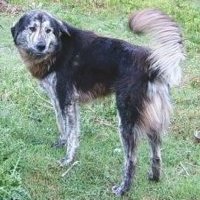This large Molosse is said to be the result of crossing Albanian Cattledogs and Sheepdogs with the wolf, but there are records to suggest that the Sarplaninac, the Spartan sheepdog and Greek dogs also played a role in its creation. The Albanian Wolfhound is very rare today, considered by many to be extinct. There is some confusion linked to its name, as there is also an Albanian Greyhound breed that is sometimes referred to as the Albanian Wolfhound. It is estimated that fewer than 50 examples of this breed survive today.
Used as a big-game hunting dog in the past, it also makes an excellent herding and guard dog. Often described as too vicious, the Albanian Wolfhound is an aggressive, independent breed best suited to the rural environment. They are deep-chested and well-boned, leaner and more agile than other Albanian dogs. The head is broad and round, with a lupoid muzzle and high ears that are sometimes cropped. The body is squarely built, with a straight back, strong neck and long legs. The tail can be docked or left in its natural state.
The medium-length coat is rich and hard, usually wolf-gray, fawn and reddish-brown, with or without white markings on feet, chest and tail. The average height is about 76 centimeters, but small dogs are common. |







 English (United Kingdom)
English (United Kingdom)